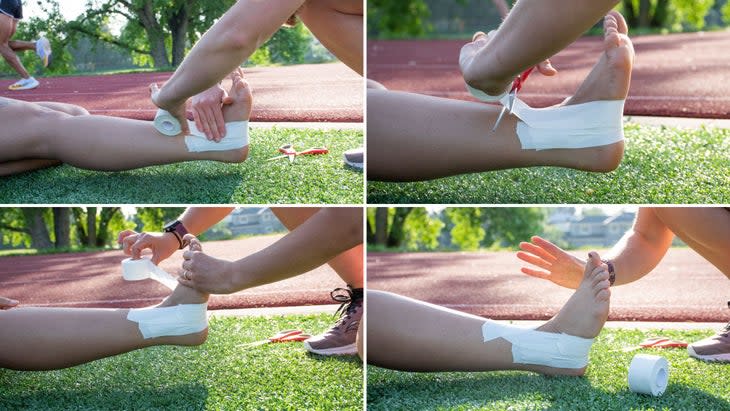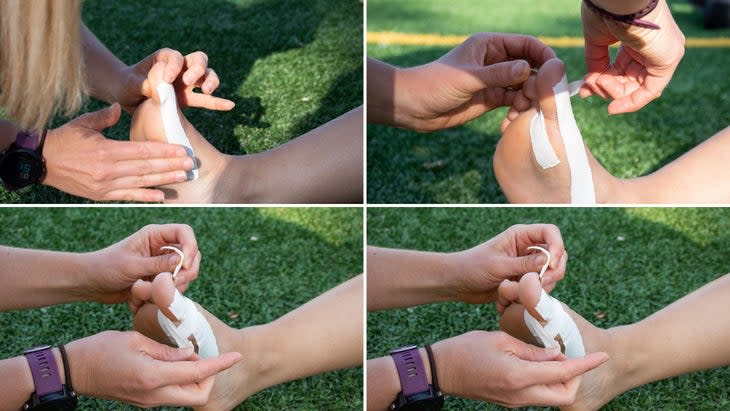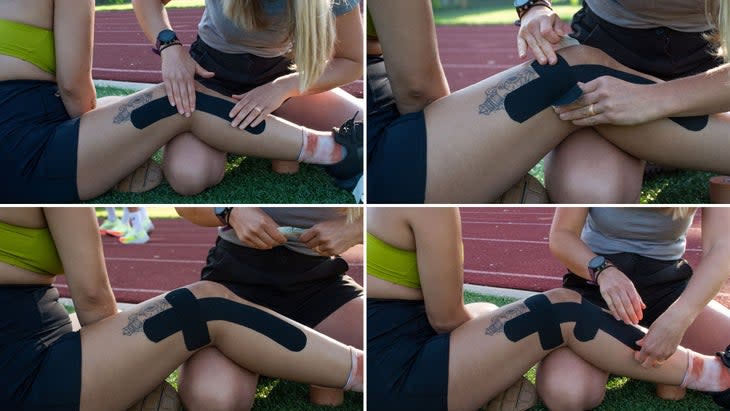How to Use Athletic Taping to Manage Injuries
This article originally appeared on Womens Running
There is nothing more frustrating than being sidelined from running-or any physical activity-due to an injury.
While all injuries are different, some, such as a sprained ankle, can benefit from the use of athletic taping methods to manage pain from the injury and prevent further damage to the joint.
Athletic taping serves an important purpose: to protect the part of the body on which the tape is applied. This type of tape is broadly known as "athletic tape" and is stretchier and more durable than standard medical tape that might be used to attach gauze to the skin.
Athletic taping can be used to both manage existing injuries and prevent new injuries.
Dr. Sarah Zimmer, DPT is a physical therapist who practices in Boulder, Colorado with PR Sports Labs. She works with athletes of all levels and is a runner and cyclist herself.
"I am passionate about keeping my community active and doing what they love pain-free," Dr. Zimmer says. "I bring a holistic approach to my treatments for patients that, in addition to other methods, may involve athletic taping to help them recover from their injuries and learn to move better."
RELATED: The Best Practices for Preventing and Treating Ankle Injuries
Types of Athletic Tape
There are a couple types of athletic tapes a practitioner may use to help prevent injury: athletic tape or Leukotape, and kinesiotape or rock tape. Both types vary by their elasticity, material, durability, and purpose.
Leukotape
"Using pure athletic tape, or Leukotape, is helpful for providing joint stability, protection, and even biofeedback to your nervous system," Dr. Zimmer says. "You can use Leukotape to stabilize and protect a part of the body if you've recently injured it or need to provide stability."
Leukotape is stiffer and has little-to-no stretch, which makes it ideal for adding stability or immobilization to a specific area of the body.
"Leukotape is great for providing support during the initial phases of rehab or to ensure extra protection," Dr. Zimmer says. "But we know it is just an assistive aid as we work toward strengthening or healing that part of the body as part of a training or rehab regimen."
Kinesiotape
Kinesiotape offers more stretch than Leukotape and can assist with improving range of motion in a particular area of the body.
"Kinesiotape provides sensory and mechanical input into the muscle tissue, which sends a different signal to your brain than the more rigid Leukotape," Dr. Zimmer says. "Kinesiotape helps target the goals of reducing swelling and increasing muscle activation, among others."
You may see runners using kinesiotape on race day on areas of the body that are chronically tight to give them every chance to expand their range of motion in a painless, non-invasive way.
"There is some research that shows that using kinesiotape on certain muscles in the ankles and knees helps increase performance and range of motion," Dr. Zimmer says. "It is definitely a valid option to bring up to your practitioner if you are hoping to prevent overuse injuries while training and during performance."
Managing Injuries
Using athletic tape is not a silver bullet when it comes to managing existing injuries. Athletes should be working with a practitioner to establish an individualized recovery plan that may also involve strength training, physical therapy exercises, and cross-training. Athletic taping can help manage existing injuries until the patient is strong enough to use the injured part of the body without the support athletic taping provides.
"There are very few adverse reactions or negative side effects with using athletic tape...as long as you are applying it correctly," Dr. Zimmer says. "However, like a bandage or brace, athletic tape is a temporary solution. Athletic tape is great for providing support during the initial phases of rehab while ensuring extra protection to help a patient get back on their feet as quickly as possible "
There are many techniques a practitioner may use to incorporate athletic tape into an injury rehabilitation program. Dr. Zimmer walks Women's Running through three of the most common ones.
RELATED: How to Use Athletic Taping to Prevent Injuries
Ankle Support
The human ankles endure a lot-they get bashed into rocks while trail running, kicked during track meets, and rolled as we stumble downhill at mile 25 of a marathon.
When an ankle sprain arises, it can keep a runner away from training for weeks. While it is recommended that an athlete dealing with an ankle injury consult with a doctor about an appropriate rehab program, athletic taping can help manage an ankle sprain in addition to other treatment methods.

Dr. Zimmer shares her technique for using athletic tape to provide ankle stability, called the Stirrup Technique:
Start with the foot pulled into dorsiflexion (AKA, flex your toes toward the sky) where the ankle and foot are at a 90-degree angle
Cut multiple strips of Leukotape (three or four strips) long enough to lay from the middle of your inner shin to the middle of your outer shin.
Start by placing the anchor of one strip along the inside of your shin, about three inches above your inner ankle bone. Pull the tape with 50% of its strength underneath the heel bone so the tape wraps around the bottom of the foot, and continue upward along the outside of the shin, stopping 3-4 inches above the outer ankle bone.
Take a second strip of athletic tape and apply in the reverse direction, starting 3-4 inches above the outer ankle bone and pull down, underneath the heel bone, and up to three inches above the inner ankle bone. Repeat with the remaining 1-2 strips making sure the heel feels secure and your ankle feels stable, meaning that the ankle is not rolling inward or outward when weight-bearing.
Bunion Support
The hallux is the "knuckle" of the big toe and is crucial in providing mobility and stability to the entire foot.
A hallux valgus deformity, or bunion, can form over months and years from many factors such as shoe choice, poor foot biomechanics, and hereditary predisposition among others.

Dr. Zimmer shares one taping technique to help manage the pain and poor foot mechanics that can come from having a hallux valgus.
Start by placing an anchor strip of Leukotape along the big-toe side of your foot. One end of the tape is placed along the middle of your big toe and is pulled with 25% strength along the inside of the foot and attached to the middle of your arch. You should feel your big toe pulled slightly outward.
Next, take a small strip of Leukotape and create a ribbon pattern around the big toe. Start with one end of the tape on the bottom of the big toe, wrap it around the inside of the toe and pull it around until you can stick it to the bottom of the big toe again (near the ball of the foot). You should continue to feel the big toe being pulled slightly outward so that it is in line with the rest of your foot.
Make sure the tape is pulled tight enough, but not so much as to restrict motion of the big toe or reduce blood flow.
IT Band Support
If you are a runner, you have likely heard of the infamous IT Band.
The illiotibial-or IT-band is a tendon that runs on the outer edge of the quad and connects at the knee. When an athlete is having trouble using their glute muscles to propel them forward and becomes quad-dominant, the IT band can attempt to "take over" for other muscles and become tender and inflamed. Runners may feel pain on the outer and upper parts of their knees, on the sides of their quads, or even near their hips.
IT band issues cannot solely be solved with athletic taping and should be addressed with a physical therapist, but incorporating Dr. Zimmer's kinesiotape method may help an athlete manage an IT band flare-up.

Bend your knee slightly for optimal positioning for the kinesiotape. The angle of your femur and tibia should be at about 120deg.
Start with a long strip of kinesiotape measures the length from your mid-thigh to the top of your shin. Anchor one end of the tape about halfway up the outside of your thigh (where the IT band is) and pull the tape along the outside of your leg, using about 25% stretch on the tape. Place the other end about 2-3 inches below the outside of the knee joint and rub the tape to secure the adhesive.
Cut two smaller strips of kinesiotape (about 3-4 inches long) that will go above and below the location of pain. Start by anchoring one above the location of pain, just outside of the first piece of tape, and pull with 25% stretch towards the middle of the quad muscle. Repeat using the second small strip and place it below the location of pain.
Remember to rub the kinesiotape for a few seconds post-application to activate the adhesives to ensure it is securely applied.
RELATED: How to Treat IT Band Syndrome
Athletic taping to manage injuries is just one resource athletes have to heal from a frustrating injury. In addition to considering using athletic taping to manage injuries, runners should work with a physical therapist or other sports medicine practitioner on treatments such as biomechanic rewiring, strength training, and manual manipulation (such as massage) to manage injuries. Athletic taping can be a vital part of healing an injury, but it is critical to learn how to treat the root of the injury, not just its symptoms, to see lasting rehabilitation progress.
For exclusive access to all of our fitness, gear, adventure, and travel stories, plus discounts on trips, events, and gear, sign up for Outside+ today.

